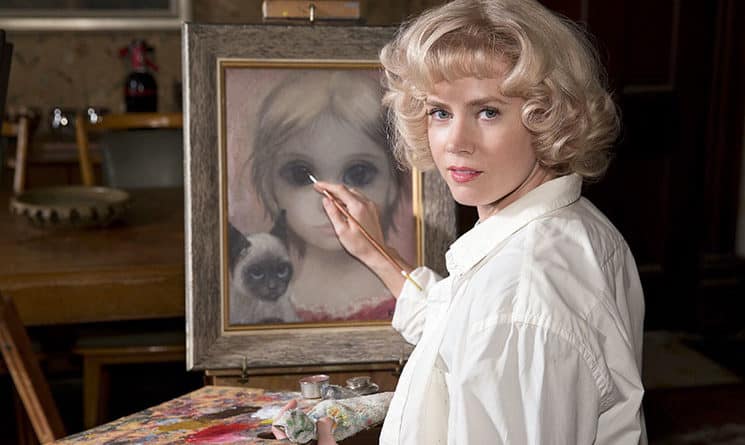2014, rated PG-13, 106 minutes
The string of brilliantly imaginative and visually mesmerizing films Tim Burton put out in the late 1980s and early 1990s (“Beetlejuice,” “Batman,” “Edward Scissorhands”) will forever endear him to a generation of moviegoers. He’s so revered for those early efforts, in fact, that he can easily be forgiven for his occasional blunders (“Planet of the Apes,” “Alice in Wonderland,” “Dark Shadows”).
With “Big Eyes,” the biographical drama released on Christmas day, Burton seems to have turned a new corner. The fantastical elements that characterize most of his work are still present, but they’re toned down, complementing the phantasmal qualities of the work created by the film’s subject: artist Margaret Keane.
The story told in “Big Eyes” is true, and that makes it all the more bizarre — and all the more ripe for Burton’s creative embellishments. Beginning in the 1950s, Margaret Keane produced hundreds of paintings of giant-eyed little girls, usually impoverished, barefoot waifs with sad expressions. The paintings became wildly popular, but her husband, Walter Keane, took all the credit. He became rich and famous, sipping cocktails and paling around with celebrities while his wife toiled for hours in her small home studio.
Since this is a true and fairly well known story, there are no spoilers: Margaret eventually left her husband and publicly revealed her secret — that she alone was the creator of every waif painting, and that Walter couldn’t paint to save his life. In the court battle that followed, Margaret was vindicated, and Walter was disgraced.
In “Big Eyes,” Margaret is played by Amy Adams, who offers a suitably meek and emotionally tense performance. Adams presents a woman who is painfully vulnerable and easily manipulated. By the time she meets Walter in San Francisco, she has left her first husband and is struggling to provide for her young daughter. Her sole passions are her art and her child.
Christoph Waltz delivers an excessively unctuous turn as Walter, who wins over Margaret with his wealth and charm and promptly begins exploiting her talent. He convinces her that her paintings will only sell if the world thinks the artist is a man, and he uses his business and marketing genius to turn her art into a commercial commodity on the scale of the hula hoop.
Waltz’s performance carries echoes of Col. Hans Landa, the charming but sadistic Nazi that propelled Waltz to fame in Quentin Tarantino’s “Inglourious Basterds.” Walter is not quite as evil as that, but he’s an outrageously greedy and devious charlatan. Waltz plays him with manic moodiness; one minute he’s wearing a wide, slimy smile, and the next he’s screaming with unrestrained rage. It’s infuriating to watch him pressure and stifle Adams, who remains timid and reserved even as her character’s frustration grows.
That dichotomy between Waltz and Adams works both for and against the film. On the one hand, the actors make it extra satisfying to watch Walter’s humiliating downfall in court, and to see Margaret finally get the credit she deserves. On the other, it’s almost stressful to watch them onscreen together, and Adams is distinctly more believable than the absurdly flamboyant Waltz.
There are other fun performances, though, including small parts for Danny Huston as a gossip columnist (and narrator of the story), Terence Stamp as an austere art critic who thinks the big-eyed waifs are kitschy trash, Jason Schwartzman as a rival gallery owner exasperated by Walter’s success, and Krysten Ritter as a friend of Margaret’s who is suspicious of Walter from the start.
Burton does a nice job of illustrating Margaret’s inner turmoil. As her guilt and frustration mount, she begins to see those giant eyes staring at her everywhere she goes — on the faces of shoppers at the grocery store, and on her own face in the mirror. Burton uses his flair for eye-grabbing imagery to appropriate effect, and he does it with a fraction of the makeup caked on Johnny Depp alone in many of his films. Burton is a real-life collector of Margaret Keane’s work, and it’s easy to see how those little waifs, with their big, dark, vaguely unsettling eyes, may have influenced his own cinematic artistry.
There are in fact several dichotomies at work in “Big Eyes.” Margaret makes her art in quiet solitude and remains hidden from public view, while her art makes a noisy splash across the country. Thousands of people are touched by her work, and yet critics see no real merit in it. It raises a question that applies to almost all pop-culture phenomena: If enough people like it, does that make it good?
That’s a question Burton, himself, has probably grappled with once or twice. With “Big Eyes,” though, he’s on a fascinating new track, one that’s worth watching with eyes open wide.

